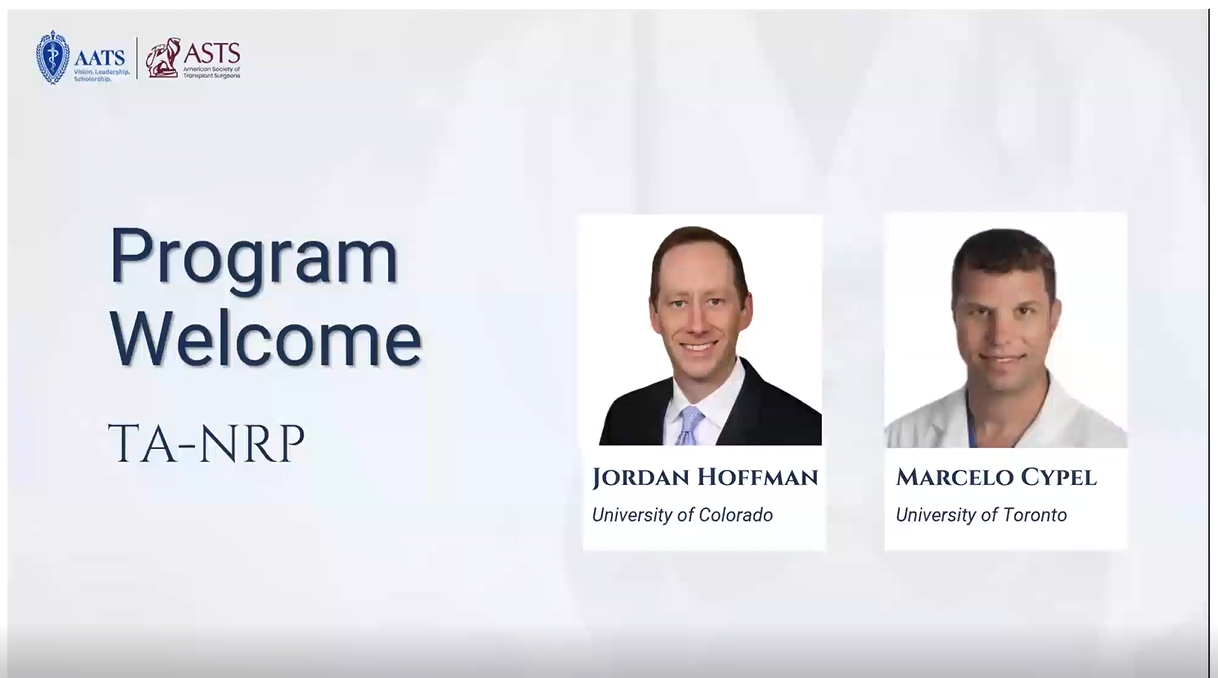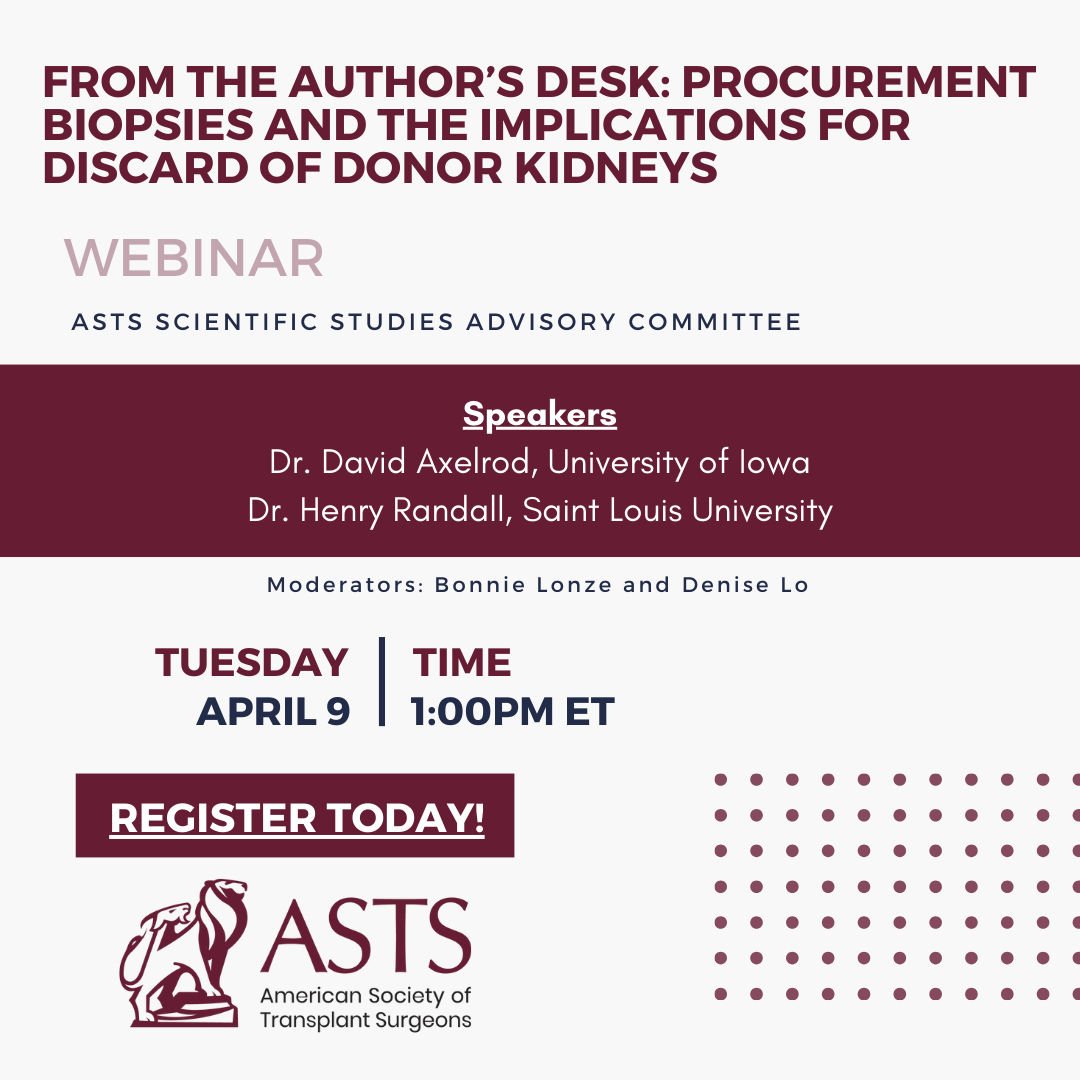
Catalog Advanced Search
-
Contains 1 Component(s) Recorded On: 04/17/2024
This is a joint webinar between the ASTS and the American Association for Thoracic Surgery (AATS). Moderators: Jordan Hoffman, MD, MPH and Dr. Marcelo Cypel
Title: TA-NRP
This webinar is a collaborative effort between the ASTS and the American Association for Thoracic Surgery (AATS), as part of AATS's Thoracic Global Grand Rounds Webinar Series.
Moderated by:
- Jordan Hoffman, University of Colorado
- Marcelo Cypel, University of Toronto
NRP- History, Technical Aspects Heart/Lung, Results/Outcomes
- Pedro Catarino, Cedars-Sinai
Ethics Pro/Con
- Brendan Parent, New York University Langone Health
Panel Discussion with Live Q&A
All faculty including:
- Nader Moazami, New York University Langone Health
- Caitlin Demarest, Vanderbilt University Medical Center
- Marty Sellers, Tennessee Donor Services
-
Register
- Non-member - Free!
- Member - Free!
- More Information
-
Contains 5 Component(s), Includes Credits
John Rice, MD
Speaker: John Rice, MD

-
Register
- Member - Free!
- More Information
-
Register
-
Contains 12 Product(s)
Medical Complications of Transplantation Unit
Medical Complications of Transplantation Unit
-
Register
- Member - Free!
- More Information
-
Register
-
Contains 5 Component(s), Includes Credits
Ryan A. Helmick, MD
Learning Objectives:
•To understand the basic immunologic principles that place transplant recipients at greater risk of cancer after transplant
•To review the increased risks of specific cancers and cancer rates within specific transplant populations
•To outline principles of post-transplant cancer surveillance and recommendations for surveillance
•To discuss the etiology and management of Post-Transplant Lymphoproliferative DisorderAuthor: Ryan A. Helmick, MD

-
Register
- Member - Free!
- More Information
-
Register
-
Contains 1 Component(s) Recorded On: 04/09/2024
Title: From the Author’s Desk: Procurement Biopsies and the Implications for Discard of Donor Kidneys Speakers: David Axelrod, MD, MBA and Henry Randall, MD, MBA, FACS
Title: From the Author’s Desk: Procurement Biopsies and the Implications for Discard of Donor Kidneys
Speakers: David Axelrod, MD, MBA and Henry Randall, MD, MBA, FACS
Moderators: Bonnie Lonze, MD, PhD and Denise Lo, MD
-
Register
- Non-member - Free!
- Member - Free!
- More Information
-
Register
-
Contains 16 Product(s)
Kidney Transplantation Unit
Kidney Transplantation Unit
-
Register
- Member - Free!
- More Information
-
Register
-
Contains 5 Component(s), Includes Credits
Daniel Zamora-Valdes, MD, MSc, FACS
Author: Daniel Zamora-Valdes, MD, MSc, FACS

Learning Objectives
To define obesity and its impact on:
1) Kidney disease
2) Kidney donation
3) Kidney transplant candidatesTo outline treatment options for obese kidney transplant candidates:
1) Before transplantation
2) During transplantation
3) After transplantation-
Register
- Member - Free!
- More Information
-
Register
-
Contains 1 Component(s) Recorded On: 03/14/2024
Fellow Presenter: Rithin Punjala, MBBS Institution: Ohio State University
Fellow Presenter: Rithin Punjala, MBBS
Institution: Ohio State University-
Register
- Member - Free!
- More Information
-
Register
-
Contains 5 Component(s), Includes Credits
William Kitchens, MD, PhD, FACS, FAST
Learning Objectives
1) Discuss the causes of long-term allograft failure
2) Investigate the pathophysiologic mechanisms of kidney allograft chronic fibrosis
3) Identify the different kinds of chronic kidney rejection (including chronic active T-cell mediated rejection and chronic active antibody-mediated rejection), and how they are diagnosed
4) Evaluate different treatment modalities of chronic kidney rejectionAuthor: William Kitchens, MD, PhD, FACS, FAST

-
Register
- Member - Free!
- More Information
-
Register
-
Contains 5 Component(s), Includes Credits
Kevin Gregg, MD
Learning Objectives:
1. Demonstrate ability to interpret hepatitis B virus serologies and molecular testing to inform post-transplant clinical care
2. Understand the risks of hepatitis B virus transmission from seropositive donors and strategies for prevention of disease transmission
3. Understand the preventive and treatment strategies for hepatitis B infection in liver transplant recipients with known infectionAuthor: Kevin Gregg, MD
Co-Author: Zoe Raglow, MD

-
Register
- Member - Free!
- More Information
-
Register

